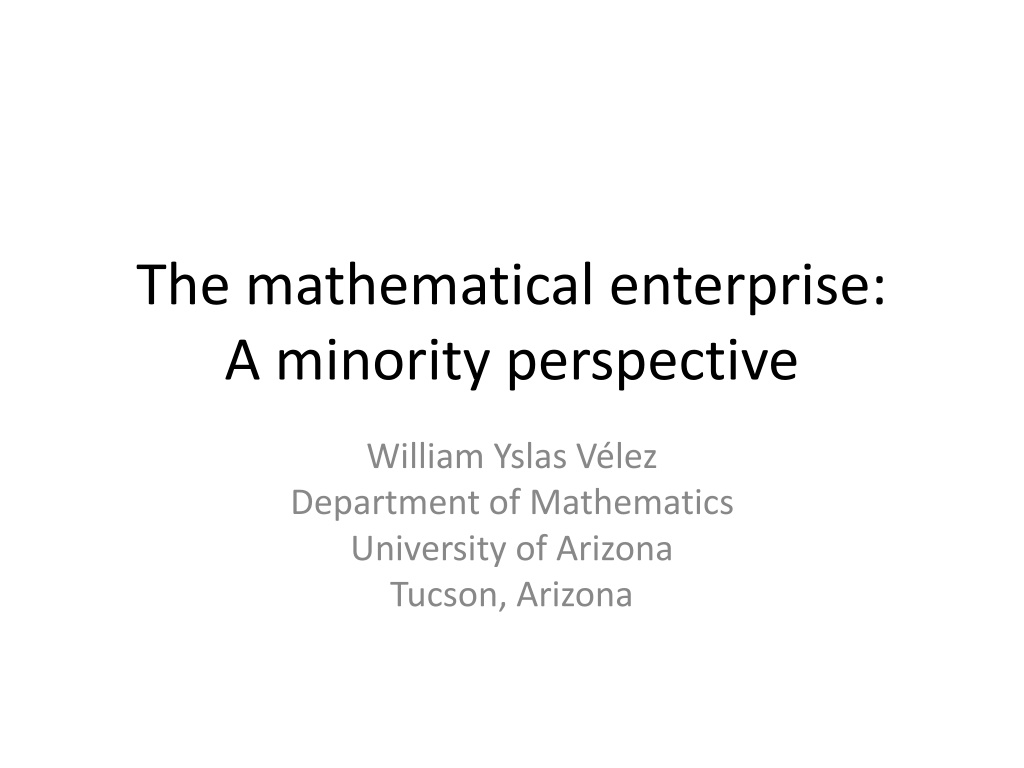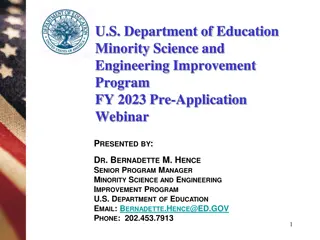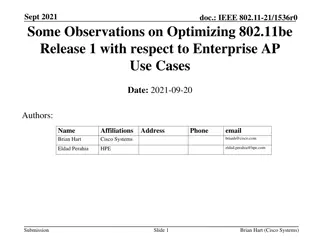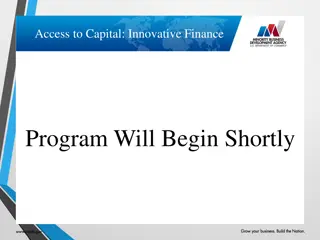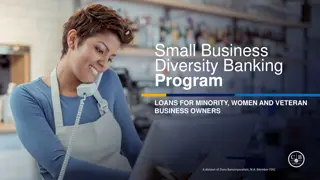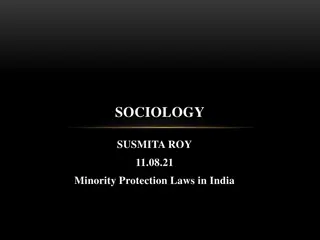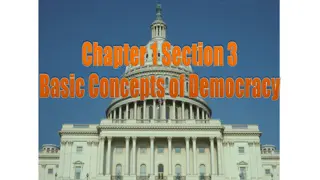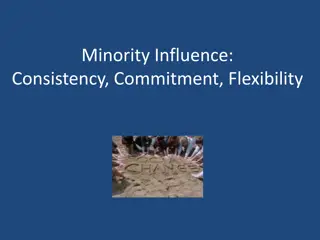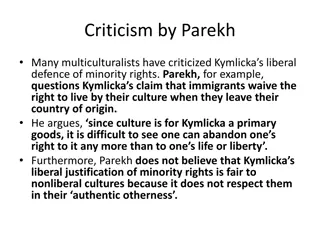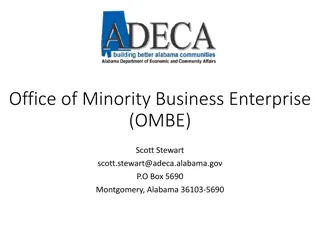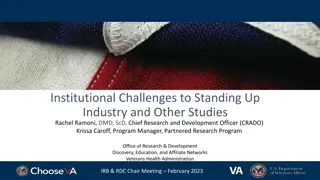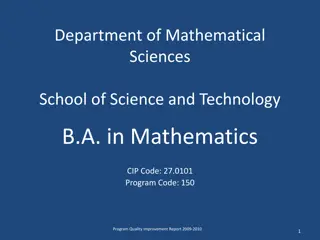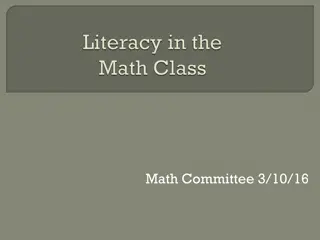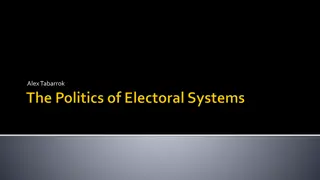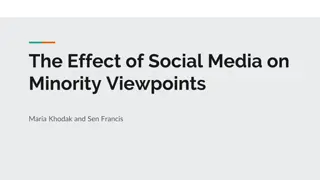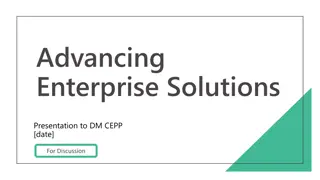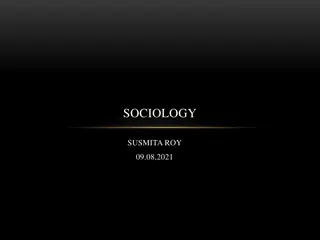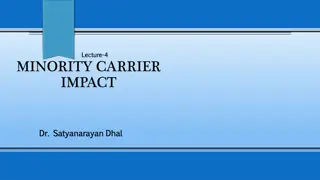Minority Perspective in Mathematical Enterprise
Explore the challenges and perspectives of minorities in the field of mathematics, addressing issues of diversity, representation, and education. Delve into the experiences and attitudes towards minority populations in academic settings, aiming to attract and support underrepresented students and faculty in universities.
Uploaded on Mar 05, 2025 | 0 Views
Download Presentation

Please find below an Image/Link to download the presentation.
The content on the website is provided AS IS for your information and personal use only. It may not be sold, licensed, or shared on other websites without obtaining consent from the author.If you encounter any issues during the download, it is possible that the publisher has removed the file from their server.
You are allowed to download the files provided on this website for personal or commercial use, subject to the condition that they are used lawfully. All files are the property of their respective owners.
The content on the website is provided AS IS for your information and personal use only. It may not be sold, licensed, or shared on other websites without obtaining consent from the author.
E N D
Presentation Transcript
The mathematical enterprise: A minority perspective William Yslas V lez Department of Mathematics University of Arizona Tucson, Arizona
Chicanos and Mexican-Americans Policy not People
Diversity, what does it mean? Mathematics departments are incredibly diverse with representatives from many continents, many languages, many cultures. But, this not what we mean by diversity. NSF has a category of historically, under- represented minorities-Hispanics, African- Americans, and Native Americans. Of course, this designation of minority applies only to US citizens or permanent residents.
Diversity The goal of diversity initiatives is to educate the children of this country. Students who go through our K-12 educational system should be able to pursue university studies and become part of our faculty. Our mathematics departments should reflect the diversity that is the make-up of this country. Diversity is not about importing international students and faculty and labeling these individuals as minorities.
Numbers of URM faculty at MIT from 2000-2009 using different definitions
How does academia handle minority issues? My experiences of dealing with minority issues in academia. The attitudes towards the minority population. What has been the minority experience in our departments?
Attracting minority students to universities One of the arguments that one sees over and over again is that we want the best students for our graduate programs. One problem with this is that the term, best , is not well defined. What do we mean by best ?
Best students? Does best mean the best prepared mathematically? It is common for math majors in other countries to have had four years of schooling where all they took was mathematics. In essence the degree is more like a master s degree. Compare this to our liberal arts degree where not more than a third of the courses can be mathematics. We created a system of education for our students and then ridicule them for having participated in it. Course work does not give a measure of the potential for creativity.
Research and international graduate students Departments claim that international graduate students are better prepared. Does this result in better research productivity. Look at the following data.
1 2 3 4 5 6 to 10 11 to 20 21-50 >51 The distribution of the total number of papers per author* *Patterns of Research in Mathematics, Notices of the AMS, January 2005 Jerrold W. Grossman
Are there barriers for minority students? Racisim in the Navy. Do mathematics departments behave in a fashion that serves to discriminate against minorities? My experience with NSA. Institutionalized racism. What well reasoned rules, regulations are in place in your department that serve to exclude the minority community from participation?
Best students? Perhaps best actually refers to us, as researchers? Who are the best students who can push forward our research careers? Who are the best students for our graduate program, ones that will make our graduate program famous?
Best students? Maybe what best means is what is best for this country? Who are the best students to promote our science in this country, students who can motivate future generations of students?
NSF strategic plan, 2006-2011 The current science and engineering workforce is aging. To meet continuing, strong demand, it will be important that every American has an opportunity to achieve in mathematics and science. Women, minorities and persons with disabilities remain underrepresented in STEM professions while they are an increasing percentage of the overall U.S. workforce.
Percentage of domestic PhDs 80% 70% 60% 50% 40% 30% 20% 10% 0%
The impact on the research I universities of the job market A doctorate from a Research I university makes that person much more competitive on the job market. Since 1992, each year about 40 % of the doctorates awarded in the US have come from Research I universities. Since 1992, about 20% of the doctorates from research I universities have not been US citizens.
What has caused this increase in the number of international graduate students? Is it that Americans don t want to study mathematics? The job market in the 1970s. Terrible Departments found out that they could attract mathematicians with better research credentials. The research capacity of mathematics departments went up.
Calculus AP AB Exam 250000 200000 150000 100000 50000 0 1995 1996 1997 1998 1999 2000 2001 2002 2003 2004 2005 2006 2007 2008 2009
Calculus AP BC Exam 80000 70000 60000 50000 40000 30000 20000 10000 0 1994 1995 1996 1997 1998 1999 2000 2001 2002 2003 2004 2005 2006 2007 2008 2009
What has caused this decrease in the number of mathematics majors? The job market has been terrible. Mathematicians don t believe that mathematics is useful. Public pronouncements by mathematicians, a window into the attitudes that mathematicians have toward the undergraduate degree in mathematics.
Public statements I was giving a talk at a university in the early 1990s on my work with minority students and a mathematician got up, in public, and asked why we should encourage minorities to study mathematics when the job market was so bad? On another occasion at NSF a mathematician got up and said he does not recommend mathematics for his students because of the job market.
Is it any wonder that there has been a decrease in the number of mathematics majors? We complain about K-12 teachers not understanding mathematics and discouraging their students from studying mathematics, while we do the same thing openly.
The pipeline If we decrease the number of undergraduate mathematics majors, we decrease the number of domestic students pursuing graduate degrees in mathematics. So, departments began to rely on international students. Mathematicians don t seem to understand the useful of an undergraduate degree in mathematics.
The impact on the minority community The decrease in the pipeline of undergraduate mathematics majors adversely affected the minority population. And university administrations have not been particularly interested in hiring minority mathematicians.
Conversations with dept. heads Me: There is a very promising Chicano mathematician on the market this year. Dept Head: We hired someone in that area recently. Me: You don t have any Chicano mathematicians on you staff. Dept head: Why do we need one?
Conversation with university president Me: There are almost no Chicano faculty in your College of Science. Univ. Pres.: Why don t we go to Latin America to recruit some?
The hiring of minority mathematicians I did an informal survey in 1978. This was followed up by Pat Kenschaft in 2004. I tried to identify all of the Chicano mathematicians at PhD granting universities in the Southwest. Why these universities?
Chicano research mathematicians at Ph.D. granting institutions in the Southwest in 1978 1. 2. 3. 4. 5. 6. 7. David Sanchez, UCLA and University of New Mexico Richard Griego, University of New Mexico Bill Torres, New Mexico State University Joaquin Bustos, Arizona State University Richard Tapia, Rice University Efraim Armendariz, University of Texas, Austin William Velez, University of Arizona Statistics 1. Francisco Samaniego, University of California, Davis a) b) There are other Hispanics at these universities. Almost no new Chicano hires were made for the next 15 years.
Chicano research mathematicians at Ph.D. granting institutions in the Southwest in the 2004* 1. 2. 3. 4. 5. 6. 7. 8. James Epperson, University of Texas, Arlington Edward Dean, University of Houston Dante DeBlassie, Texas A & M Oscar Gonzales, Univeristy of Texas, Austin Carlos Castillo-Chavez, Arizona State University Richard Tapia, Rice University EfraimArmendariz, University of Texas, Austin William Velez, University of Arizona Statistics 1. 2. 3. Francisco Samaniego, University of California, Davis Rudy Guerra, Rice University Javier Rojo, Rice University *Pat Kenschaft, Change in Possible
How do we educate our citizenry? Given the current pipeline problems, it is difficult to find talented minority students for our faculty lines. More attention needs to be paid to recruiting domestic students into our graduate programs. The current percentages are out of balance. There are departments that have developed models to increase minority participation. There are mathematicians that have managed to increase minority participation. Why aren t these examples and models being emulated across the country? Society for the Advancement of Chicanos and Native Americans in Science. Are there domestic/minority students willing to study mathematics?
Some Examples Society for the Advancement of Chicanos and Native Americans in Science www.sacnas.org The SACNAS biography project The annual meeting
The Iowa Alliance About 25% of the graduate students in the mathematics department are minority students. http://www.mathalliance.org/
People Carlos Castillo-Chavez at Arizona State University Richard Tapia at Rice Javier Rojo at Rice Many others
My own efforts at the University of Arizona Number of Mathematics majors 295 327 323 307 456 472 505 564 565 570 % of minority students ~15% ~15% ~15% ~15% ~15% 16% 19% 22% 22% 21% Number of mathematics minors Number of graduates 199 355 390 447 531 487 527 572 562 560 % of minority graduates 13% 17% 8% 6% 20% 8% 13% 15% 19% 20% Year 2000-01 2001-02 2002-03 2003-04 2004-05 2005-06 2006-07 2007-08 2008-09 2009-10 46 52 59 50 65 62 82 79 69 100
In closing: How do we increase diversity? Increase the overall pool. Focusing on recruiting faculty is too long range. What can elite universities do to increase the pool of minority undergraduates? Inviting students into the major. Our mathematics courses should be the most effective recruiting tool that we have. Opening up opportunities for mathematics majors and mathematicians.
